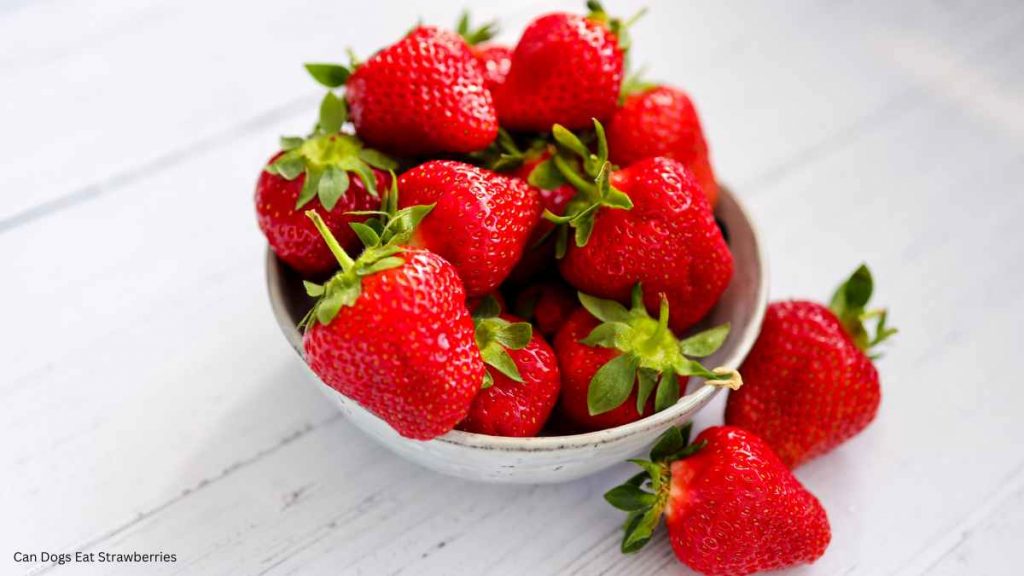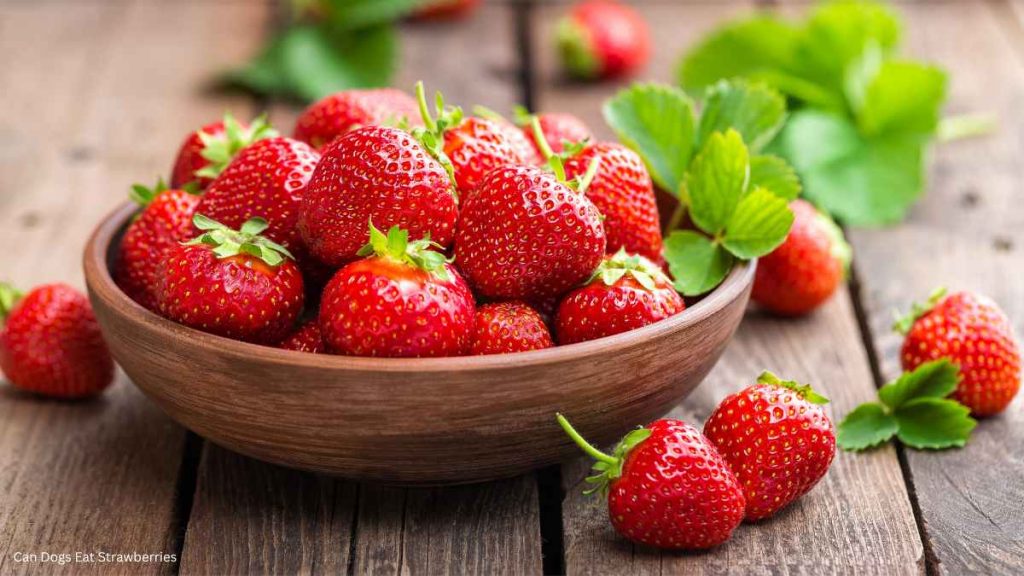Can dogs eat strawberries? As responsible pet owners, it is crucial to be knowledgeable about the foods we feed our furry companions. Understanding which foods are safe and healthy for dogs is vital to ensure their well-being and avoid any potential health risks. Strawberries are a popular and nutritious fruit enjoyed by humans, but can dogs also indulge in this delightful treat?
In this article, we will explore the topic of whether strawberries are suitable for canine consumption. We will delve into the nutritional benefits that strawberries offer for dogs, including their rich content of vitamins, minerals, and antioxidants. However, it is equally essential to be aware of the potential risks associated with feeding strawberries to dogs, such as allergies or adverse reactions. To ensure our four-legged friends can safely enjoy this fruit, we will provide precautions and guidelines on how to introduce strawberries into their diet. Let’s embark on this journey of discovering if strawberries can be a healthy addition to our canine companions’ meals.
Table of Contents
Nutritional Benefits of Strawberries for Dogs
A. Highlight the nutrients present in strawberries that can be beneficial for dogs.
Strawberries are packed with essential nutrients that can offer several health benefits to dogs. One of the key nutrients found in strawberries is Vitamin C, which supports the immune system and helps in collagen formation for healthy skin and joints. Additionally, strawberries contain dietary fiber that aids in digestion and promotes bowel regularity.
The presence of antioxidants, such as anthocyanins and quercetin, can contribute to reducing inflammation and combating free radicals in the body. Moreover, strawberries are a good source of manganese, which plays a role in bone health and metabolism regulation. The combination of these nutrients makes strawberries a potentially valuable addition to a dog’s diet.
B. Discuss the potential health advantages, such as vitamins, minerals, and antioxidants.
The health advantages of incorporating strawberries into a dog’s diet are manifold. The Vitamin C content in strawberries can provide a natural boost to the immune system, assisting the body in fighting off infections and diseases. Furthermore, the antioxidants present in strawberries may contribute to the reduction of oxidative stress, promoting overall cellular health and potentially lowering the risk of chronic conditions in dogs.
The dietary fiber in strawberries can aid in maintaining healthy digestion and may alleviate gastrointestinal issues such as constipation. Additionally, strawberries’ mineral content, particularly manganese, supports bone health and aids in the proper functioning of enzymes within the body.
It is essential, however, to remember that while strawberries offer these potential benefits, moderation is key to avoid overfeeding and any adverse effects that excessive consumption might cause. Before incorporating strawberries into a dog’s diet, it is crucial to consult with a veterinarian, especially if the dog has any pre-existing health conditions or food allergies.

Potential Risks of Feeding Strawberries to Dogs
A. Address the possible adverse effects of strawberries on dogs’ health.
While strawberries can offer nutritional benefits, there are also potential risks associated with feeding them to dogs. One of the main concerns is the natural sugar content in strawberries. Consuming too many strawberries can lead to an increase in sugar intake, which may contribute to weight gain and dental issues in dogs.
Moreover, excessive strawberry consumption can cause gastrointestinal upset, leading to symptoms like diarrhea or vomiting. It is essential to provide strawberries in moderation to avoid these adverse effects and to balance them with the dog’s overall diet.
B. Identify specific components of strawberries that may be harmful to dogs.
Certain components of strawberries can be potentially harmful to dogs. The seeds on the outer surface of strawberries may pose a choking hazard or cause gastrointestinal irritation if ingested in large quantities.
Additionally, the leaves and stems of strawberries contain oxalates, which, if consumed in large amounts, can lead to kidney issues in some dogs. Therefore, it is crucial to remove the leaves, stems, and any overripe or mushy parts of the strawberry before offering them to dogs.
C. Highlight any potential allergies that some dogs might have to strawberries.
Just like humans, dogs can develop allergies to certain foods, and strawberries are no exception. Some dogs may be allergic to the proteins present in strawberries, leading to allergic reactions. Common symptoms of a strawberry allergy in dogs include itching, skin irritation, hives, swelling, and digestive disturbances.
If a dog shows any signs of an allergic reaction after consuming strawberries, it is vital to discontinue feeding them this fruit and consult a veterinarian for proper evaluation and guidance.
Precautions and Considerations
A. Discuss the importance of moderation in feeding strawberries to dogs.
Moderation is key when it comes to feeding strawberries to dogs. While strawberries offer nutritional benefits, they should only be given as an occasional treat and not as a primary food source. Too many strawberries can lead to an excessive intake of natural sugars, which may contribute to weight gain and other health issues in dogs.
Additionally, overfeeding strawberries can cause gastrointestinal upset, such as diarrhea or vomiting. As a general guideline, strawberries should make up only a small portion of a dog’s overall diet to ensure they receive a balanced and nutritious meal.
B. Identify factors to consider before introducing strawberries into a dog’s diet.
Before introducing strawberries into a dog’s diet, several factors should be considered. Firstly, it is crucial to check for any allergies the dog may have to strawberries or related fruits. A gradual introduction is recommended to monitor the dog’s response and to avoid any adverse reactions. Additionally, the dog’s overall health and any existing medical conditions should be taken into account.
For example, dogs with diabetes or weight issues may require stricter control of their fruit intake. Also, consider the size and breed of the dog, as smaller dogs may need smaller portions to avoid excessive sugar intake. Always opt for fresh, organic strawberries to minimize the risk of exposure to pesticides or other harmful chemicals.
C. Mention the significance of consulting a veterinarian for individualized advice.
Before incorporating strawberries into a dog’s diet, it is crucial to consult a veterinarian for personalized advice. A veterinarian can assess the dog’s specific health needs, dietary requirements, and potential allergies to determine whether strawberries are a suitable addition to their meals.
They can provide guidance on portion sizes, frequency, and any specific precautions to take based on the dog’s individual health profile. Furthermore, if the dog has any pre-existing medical conditions or is on medication, a veterinarian’s input is essential to ensure that strawberries won’t interfere with their treatment. Veterinarians are well-equipped to offer expert advice to ensure the dog’s overall well-being and safety when introducing new foods like strawberries into their diet.
Safe Ways to Feed Strawberries to Dogs
A. Present different methods of preparing strawberries for dogs to eat.
When offering strawberries to dogs, it’s essential to prepare them in a dog-friendly manner. Here are some safe methods:
1. Fresh and Whole: Wash fresh strawberries thoroughly and remove the stems and leaves before offering them as a whole treat. This method allows dogs to enjoy the natural taste and texture of strawberries.
2. Sliced: For smaller dogs or to prevent choking hazards, slice the strawberries into small, manageable pieces. This also makes it easier to mix them into other dog-friendly foods.
3. Mashed: Mash strawberries and mix them with a dog’s regular food to add flavor and nutrition to their meal. Ensure there are no added sugars or sweeteners when using this method.
B. Discuss the ideal portion sizes for dogs based on their size and breed.
The ideal portion size of strawberries for dogs varies based on their size, breed, and individual dietary needs. As a general rule, strawberries should only comprise about 10% of a dog’s total daily calorie intake. For small breeds, such as Chihuahuas or Toy Poodles, a couple of slices or half a strawberry per day should be sufficient.
Medium-sized dogs, like Beagles or Bulldogs, can safely consume one to two whole strawberries per day. Larger breeds, such as Labradors or Golden Retrievers, can have up to three to four strawberries daily. Always monitor the dog’s weight and adjust the portion size accordingly to avoid overfeeding and maintain a healthy balance.
C. Include ways to incorporate strawberries into homemade dog treats.
Strawberries can be a tasty addition to homemade dog treats. Here are some creative ideas:
1. Frozen Treats: Blend strawberries with plain yogurt and freeze them in molds to create delicious and refreshing summer treats for dogs.
2. Baked Treats: Incorporate mashed strawberries into homemade dog biscuit recipes to add a fruity twist. Be mindful of other ingredients used, ensuring they are safe for dogs.
3. Smoothies: Create dog-safe smoothies by blending strawberries with other dog-friendly fruits like blueberries or bananas. Avoid adding any sweeteners, dairy products, or xylitol, as these can be harmful to dogs.
4. Dehydrated Snacks: Slice strawberries thinly and dehydrate them to make chewy, natural treats for dogs. This method preserves the nutrients and intensifies the flavor.
Remember, while strawberries can be a delightful and nutritious treat, they should never replace a balanced and complete dog diet. Always consult with a veterinarian before making any significant changes to a dog’s diet or introducing new foods like strawberries, especially if the dog has any health concerns or dietary restrictions.
Signs of Allergic Reactions or Negative Effects
A. List common signs that a dog might be having an allergic reaction to strawberries.
1. Skin Irritation: Dogs experiencing an allergic reaction to strawberries may develop red, itchy, or inflamed skin. This can manifest as hives, rashes, or general discomfort.
2. Itching and Scratching: Excessive itching and scratching, especially around the face, ears, paws, or belly, can be a sign of an allergic response to strawberries.
3. Swelling: Allergic dogs may experience facial swelling, particularly around the eyes, muzzle, or lips.
4. Gastrointestinal Distress: Digestive issues such as vomiting or diarrhea may occur in dogs with strawberry allergies.
5. Respiratory Symptoms: Wheezing, coughing, or difficulty breathing can be indicative of a severe allergic reaction, which requires immediate veterinary attention.
B. Highlight other symptoms that may indicate strawberries are causing issues.
Apart from allergic reactions, some dogs may experience adverse effects from consuming strawberries, even if they are not allergic. These issues might include:
1. Upset Stomach: Overeating strawberries can lead to gastrointestinal upset, resulting in symptoms like diarrhea, vomiting, or general discomfort.
2. Choking Hazard: The small seeds on the surface of strawberries can pose a choking risk, especially in smaller dogs or those who eat quickly without chewing thoroughly.
3. Tooth Decay: Strawberries contain natural sugars, which, if consumed excessively, can contribute to tooth decay and dental issues in dogs.
4. Gastrointestinal Blockage: Swallowing large strawberry pieces or stems might cause gastrointestinal blockages, especially in dogs prone to gulping their food.
5. Kidney Problems (Rare): The oxalates present in strawberry leaves and stems, if consumed in large quantities, might lead to kidney issues in some dogs.
If a dog exhibits any of these symptoms after consuming strawberries, it is essential to discontinue offering them this fruit and seek advice from a veterinarian. Additionally, if a dog has a known history of allergies or sensitivities to other fruits or foods, it is essential to approach strawberries with caution and monitor for any adverse effects. Remember that every dog is unique, and what suits one dog may not be suitable for another, so being observant and cautious when introducing new foods into a dog’s diet is crucial for their well-being.

Other Fruits for Dogs
A. List of other fruits that are safe and healthy for dogs to consume:
1. Apples: Rich in fiber, vitamins A and C, and low in fat, apples can be a crunchy and refreshing treat for dogs. However, remove the seeds and core, as apple seeds contain cyanide, which is toxic to dogs.
2. Blueberries: Packed with antioxidants, vitamins, and fiber, blueberries are a superfood for dogs. They can support overall health and may help improve cognitive function in aging dogs.
3. Watermelon: A hydrating and tasty fruit, watermelon is safe for dogs when seeds and rind are removed. It contains vitamins A, B6, and C, as well as potassium, which promotes heart health.
4. Bananas: High in potassium and vitamin B6, bananas make for a healthy and energy-boosting treat for dogs. They are also easy to digest and can help regulate digestive functions.
5. Pineapple: A tropical treat, pineapple contains bromelain, an enzyme that aids in digestion. It is a good source of vitamin C, manganese, and dietary fiber for dogs.
6. Peaches: Offered in moderation and with the pit removed, peaches provide vitamins A and C, as well as fiber. Avoid canned peaches with added sugars.
7. Pears: A source of fiber and vitamin C, pears can be a sweet and juicy treat for dogs. Remove the seeds and core before feeding.
B. Nutritional benefits of each fruit and any potential risks:
1. Apples: Apples contain fiber to support digestion and vitamins A and C for immune health. The seeds’ cyanide content is harmful, so be sure to remove them.
2. Blueberries: Rich in antioxidants, blueberries can help reduce oxidative stress and support brain function. They are low in calories and safe for most dogs.
3. Watermelon: With high water content and vitamins, watermelon is hydrating and nutritious. Remove the seeds and rind, as they can cause gastrointestinal issues.
4. Bananas: Bananas are a good source of potassium, promoting heart health and muscle function. Their high sugar content means they should be given in moderation.
5. Pineapple: Pineapple contains bromelain, aiding in digestion and reducing inflammation. Too much pineapple can upset a dog’s stomach due to its enzyme content.
6. Peaches: Peaches offer vitamins A and C but should be given sparingly due to their high sugar content. The pit contains cyanide, making it toxic to dogs.
7. Pears: Pears provide fiber and vitamins A and C. Avoid the seeds as they contain traces of cyanide.
Always introduce new fruits slowly to observe any potential adverse reactions. It’s essential to offer fruits in moderation to prevent any digestive issues or excessive calorie intake. If a dog has any known allergies or sensitivities, consult with a veterinarian before introducing new fruits into their diet.
Conclusion
A. Summarize the main points of the outline.
Throughout this article, we have explored the question of whether dogs can eat strawberries and examined various aspects related to their safety and benefits. We highlighted the nutritional advantages of strawberries, including their vitamins, minerals, and antioxidants that can support a dog’s health.
However, we also addressed potential risks, such as allergies, choking hazards, and the importance of moderation in feeding strawberries to dogs. We discussed safe preparation methods and portion sizes for different dog sizes and breeds. Additionally, we delved into other fruits that are safe and nutritious for dogs, outlining their nutritional benefits and potential risks.
B. Emphasize the importance of knowing what foods are safe for dogs.
Understanding what foods are safe and healthy for our canine companions is crucial to their overall well-being. Dogs have different dietary needs than humans, and certain foods that are safe for us can be harmful to them. Being informed about safe food choices for dogs helps prevent potential health risks and ensures they receive a balanced and nutritious diet.
It is vital for pet owners to research, consult with veterinarians, and stay updated on the latest information regarding dog nutrition to make informed decisions when selecting foods for their furry friends.
C. Encourage responsible and informed decision-making when feeding strawberries or any other food to dogs.
When it comes to feeding strawberries or any other new food to dogs, responsible and informed decision-making is essential. While strawberries can be a healthy treat in moderation, we must be cautious of potential allergic reactions and negative effects. Always introduce new foods gradually and observe the dog’s response. Consult a veterinarian if there are any uncertainties or if the dog has a history of allergies.
Understanding portion sizes, removing any choking hazards, and choosing fresh, organic fruits can contribute to safe and enjoyable fruit consumption for dogs. As responsible pet owners, our commitment to our furry companions’ well-being includes making thoughtful choices about their diet and ensuring their health and happiness.
You May Also Like:
Can Dogs Eat Jelly? Find Out Here
Can Dogs Eat Pirates Booty? A Look at the Risks and Benefits


1 thought on “Can Dogs Eat Strawberries? What You Need to Know”